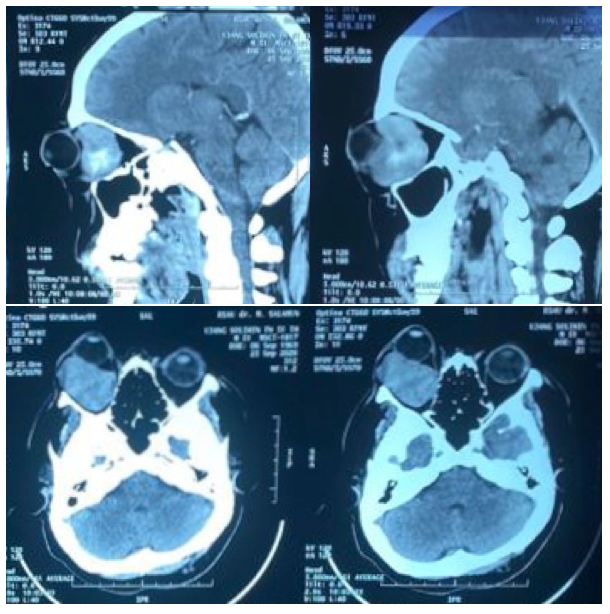VISUAL IMPROVEMENT FOLLOWING THE REMOVAL OF CHRONIC ORBITAL CAVERNOUS HEMANGIOMA
DOI:
https://doi.org/10.35749/journal.v49i2.100761Keywords:
cavernous hemangioma, anterior orbitotomyAbstract
Introduction: Orbital cavernous hemangioma is a benign, well-defined vascular lesion, located mainly in the intraconal space. Surgical treatment is indicated in symptomatic cases, such as proptosis or visual disturbance. This study aims to report the visual improvement of the successfully-managed chronic orbital cavernous hemangioma.
Case Report: A 51-year-old man came to Cicendo Eye Hospital with chief complaint of protrusion of the right eye for seventeen years, accompanied by blurred vision two years earlier. Ophthalmological examination revealed decreased visual acuity, together with ocular movement restriction and relative afferent pupillary defect. Computed tomography (CT) scan showed a retrobulbar mass, attached to the lateral and medial rectus muscle, and shifting the optic nerve superiorly. The tumor was removed through inferior anterior orbitotomy with a transconjunctival incision, and the histopathological finding revealed a cavernous hemangioma. Follow-up examination showed improvement in the patient's condition, measured by no protrusion remaining and the achievement of best-corrected visual acuity (BCVA) of 1.0.
Discussion: In the case of a benign intraorbital tumor, the orbitotomy approach should be best selected based on its anatomical location and involvement of adjacent structures. Despite the size of the tumor, chronic duration, and disturbing manifestation, improvement of visual acuity and structural appearance could be achieved if the tumor is removed correctly and the adjacent structure has not been severely damaged.
Conclusion: Cavernous hemangioma is a benign lesion in which surgical treatment is indicated in symptomatic cases. The right approach of orbitotomy is needed to give a good outcome anatomically and functionally.
Downloads
References
Santiago Y, Fay A. Orbital Vascular Anomalies. In : Clinical Ophthalmic Oncology - Orbital Tumors. 3rd ed. Cham: Springer; 2019. p. 84–5.
Calandriello L, Grimaldi G, Petrone G, Rigante M, Petroni S, Riso M, dkk. Cavernous venous malformation (cavernous hemangioma) of the orbit: Current concepts and a review of the literature. Surv Ophthalmol. 2017;62(4):393–403.
Sullivan TJ. Vascular Anomalies of the Orbit—a Reappraisal. Asia-Pacific J Ophthalmol. 2018;7(5):356–63.
Kim MH, Kim ÃJH, Kim E, Yang S. Surgical Outcomes of Intraconal Cavernous Venous Malformation According to Their Location in Four Right-Angled Sectors. J Craniofac Surg. 2019;30(6):1700–5.
Bagheri A, Jafari R, Salour H, Aletaha M, Yazdani S. A new surgical technique for excision of orbital cavernous hemangioma?: a 15-year experience. Orbit. 2018;00(00):1–9.
Dutton J, Elner V. Orbital Tumors. In: Smith and Nesi’s Ophthalmic Plastic and Reconstructive Surgery. 3rd ed. New York: Springer; 2012. p. 826–8.
Mariniello G, Ph D, Elefante A, Liuzzi R, Ph D. Risks and Benefits of Surgical Excision of Orbital Cavernous Venous Malformations ( So-Called Cavernous Hemangioma ): Factors Influencing the Outcome. Ophthalmic Plast Reconstr Surg. 2020;1–7.
Zhang L, Li X, Tang F, Gan L, Wei X. Diagnostic Imaging Methods and Comparative Analysis of Orbital Cavernous Hemangioma. Front. Oncol. 2020;10(9):1–6.
Costan VV, Sava A, Carauleanu A, Costea CF, Cucu AI, Dimitriu G, dkk. Histopathological and Clinical Characteristics of Surgically Removed Cavernous Venous Malformations ( so-called Cavernous Hemangiomas ) of the Orbit. Rev Chim. 2019;(1):3–7.
Meyer DR, Pelton R. Anterior Orbitotomy. In: Manual of Oculoplastic Surgery. 5th ed. Cham: Springer; 2018. p. 443–52.
Chana S, Azam M, Memon AA. Proptosis: Management outcomes and complications following orbitotomy. JSZMC. 2017;8(3):1235–7.

Downloads
Published
Issue
Section
Categories
License
Copyright (c) 2023 Raisha Pratiwi Indrawati, M. Rinaldi Dahlan

This work is licensed under a Creative Commons Attribution-NonCommercial-ShareAlike 4.0 International License.
